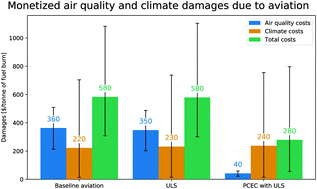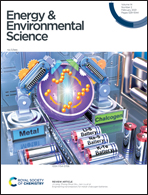Post-combustion emissions control in aero-gas turbine engines†
Abstract
Emissions of nitrogen oxides (NOx) from aircraft cause air quality degradation and climate change. Efforts to improve the efficiency of aircraft propulsion systems are leading to small, power-dense engine cores with higher overall pressure ratios and combustion temperatures, which can result in higher NOx emissions. The trend towards smaller engine cores with smaller mass flow rates in the core stream, presents new opportunities for emissions control. Specifically, we propose and assess using a selective catalytic reduction (SCR) system that was previously infeasible when mass flow rates in the core were an order of magnitude larger than heavy-duty diesel engines for road based applications. SCR systems would reduce NOx emissions at the cost of increased aircraft weight and specific fuel consumption due to the pressure drop in the core stream induced by the catalyst. We quantify the effects of these trade-offs in terms of emissions reduction and fuel burn increase using representative engine cycle models provided by a major aero-gas turbine manufacturer. Due to its size, any SCR system will likely need to be housed in the aircraft body, potentially making it most suitable for future hybrid- or turbo-electric aircraft designs. Furthermore, SCR systems require ultra-low sulfur (ULS) fuel to prevent catalytic fouling. We find that employing an ammonia-based SCR results in an approximately 95% reduction in NOx emissions in exchange for a ∼0.5% increase in block fuel burn. The performance of the post-combustion emissions control (PCEC) system is shown to improve for smaller-core engines, such as those proposed in the NASA N + 3 time-line (2030–2035). Using a global chemistry-transport model we estimate that PCEC used with ULS fuel, could avert ∼92% of aviation air pollution related early deaths each year. Using a simplified climate model and accounting for changes in emissions (including life cycle emissions) and radiative forcing we estimate that PCEC with ULS fuel increases climate damages by ∼7.5%. We estimate that the net benefit of using PCEC accounting for air quality and climate impacts is 304 USD (2015) per metric tonne of jet fuel burned, or a reduction of ∼52% in monetized air quality and climate damages.



 Please wait while we load your content...
Please wait while we load your content...